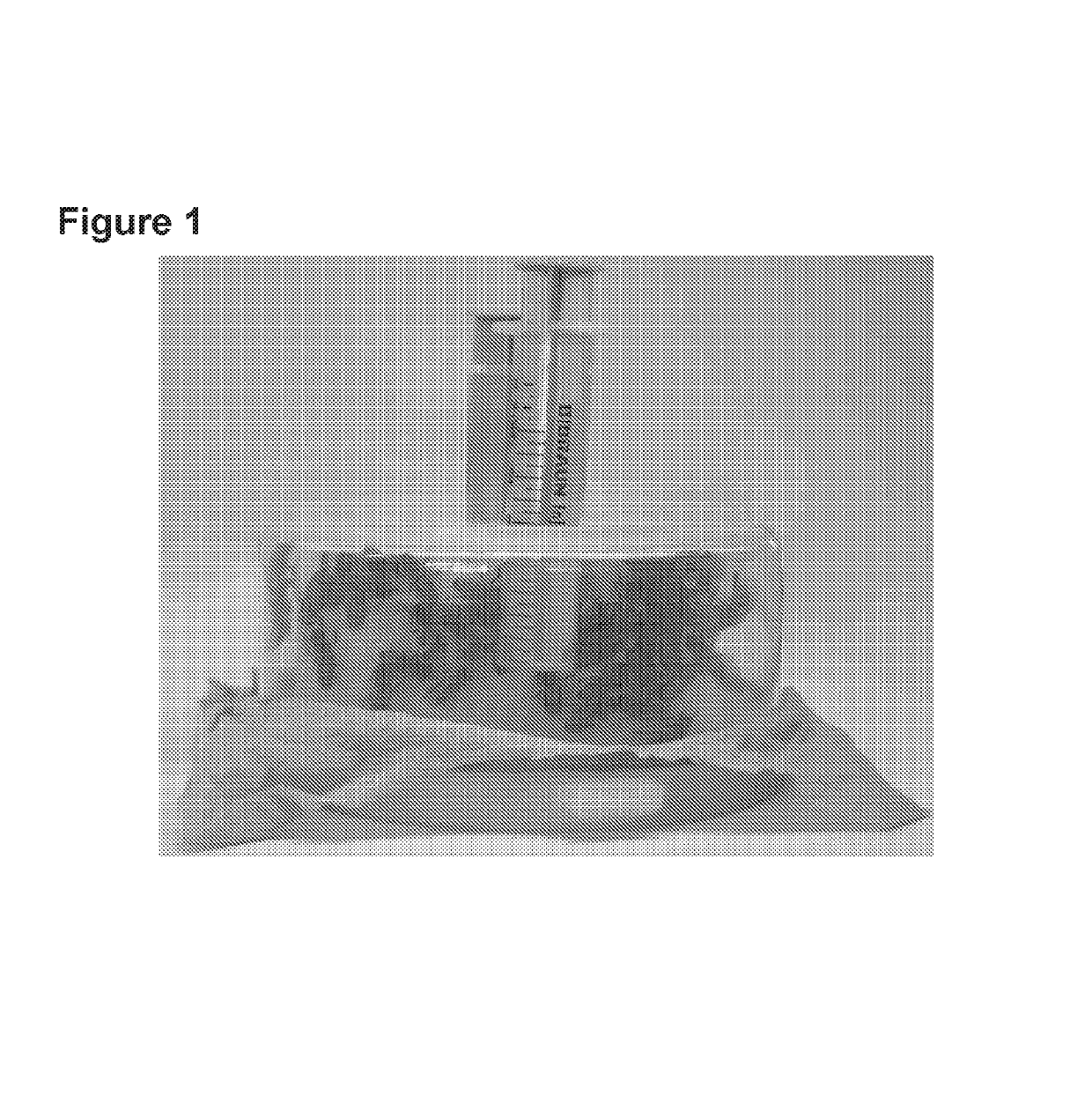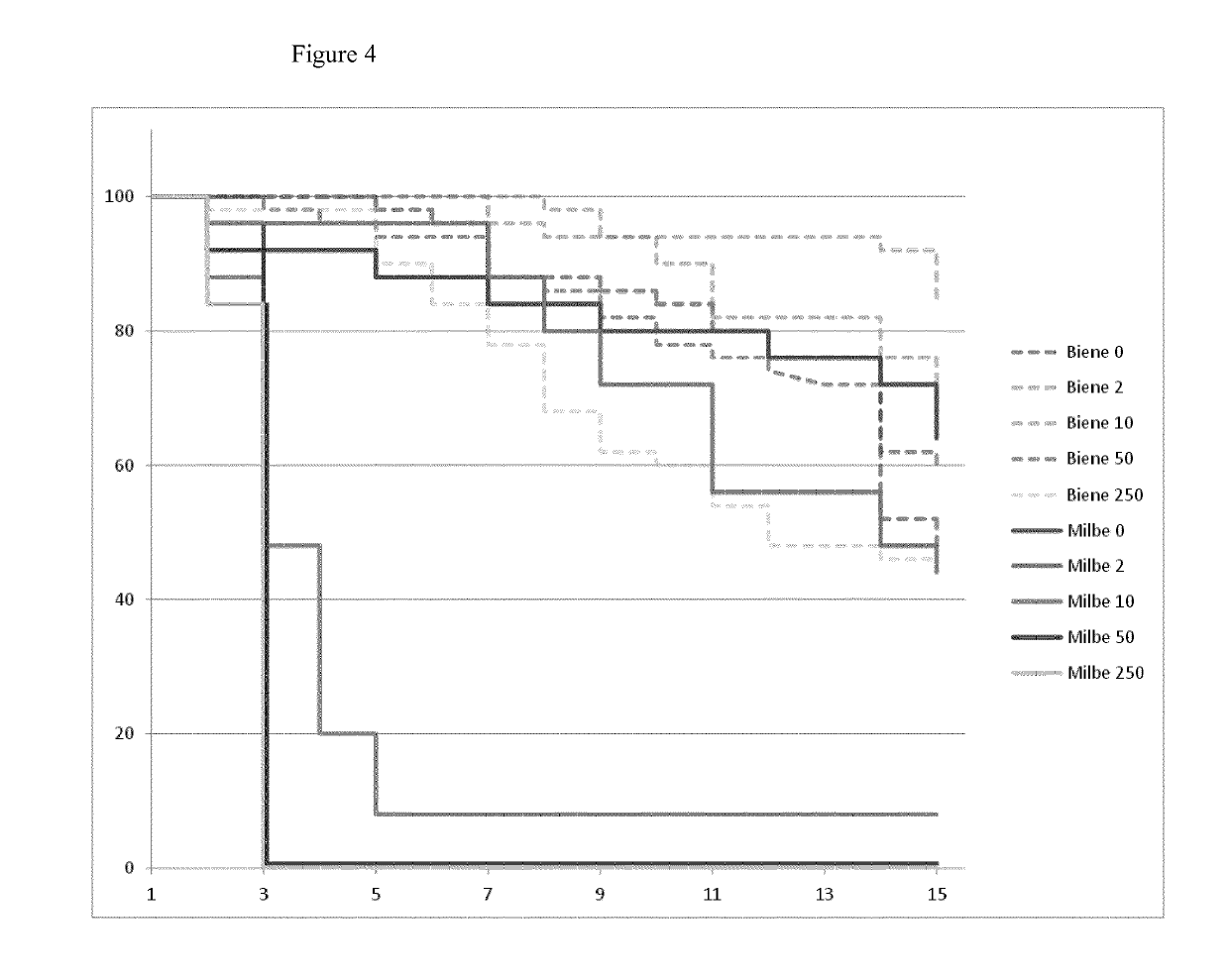Alkali metal salt for use in treatment of Varroa destructor mite infestation of honey bees
a technology of varroa destructor and alkali metal salt, which is applied in the field of therapeutic treatment of varroa destructor infestation of bees, can solve the problems of honey bee colony death, honey bee colony threat worldwide agriculture, and injured bees are also more prone to infections, so as to achieve good compromise and negatively affect the health of bees
- Summary
- Abstract
- Description
- Claims
- Application Information
AI Technical Summary
Benefits of technology
Problems solved by technology
Method used
Image
Examples
experiment 4
icidal Effect of MgCl2
[0115]To test the activity of bivalent ions we dissolved MgCl2 in sucrose syrup at a final concentration of 100 mM. 2 cages of 50 bees to which 20 mites were added were fed with sucrose syrup only and syrup containing 100 mM MgCl2. No impact on viability was seen for the control cage, however MgCl2 appeared to impair bee health substantially. Moreover, only reduced amounts of sucrose syrup with MgCl2 was taken up by the bees.
Experiment 5—Comparison of Acaricidal Effects of LiCl, NaCl and MgCl2
[0116]In a further experiment LiCl, NaCl and MgCl2 were selected and their acaricidal activity compared. The experiment was performed in cages of 50 bees, to each of which 25 mites were added. Bees in control cages received sucrose only. LiCl, NaCl or MgCl2 were added to 70% sucrose solutions at a final concentration of 25 mM each and fed to the bees for seven days. Survival rate of bees and mites were monitored daily. Dead bees and mites were removed from the cages.
[0117...
experiment 6
icidal Effect of Various Lithium Salts
[0120]To test the acaricidal activity of further lithium salts, Li-citrate, Li-sulfate, Li-acetate, Li-lactate and Li-carbonate were dissolved in sucrose syrup at a final concentration of 25 mM. Each Li-salt was tested in cages of 50 bees to which 25 mites were added and replicated three times (results in Table 3 represent mean values). The bees were fed with Li-salt / sucrose solutions for 7 days. Survival rate of bees and mites were monitored daily and dead bees or mites were removed.
[0121]As can be seen from Table 3, bees treated with 25 mM Li-citrate, Li-sulfate, Li-acetate, Li-lactate or Li-carbonate lose all mites during the course of 7 days. The majority of mites is killed within the first 72 hours implying a high activity of said Li-salts against Varroa destructor.
[0122]
TABLE 3Li-salt(25 mM)Day1234567SumLi-sulfateNumber of dead bees0.00.00.01.03.71.70.06.3Number of dead mites0.718.05.70.70.00.00.025.0Li-citrateNumber of dead bees0.00.00.30...
experiment 7
ffect of LiCl in Mini-Hives
[0125]In order to investigate if the miticidal effect of LiCl can also be detected under semi-field conditions, so-called “mini-hives” consisting of 2000 to 3000 bees each were treated with LiCl.
[0126]LiCl was dissolved in 70% sucrose to final concentrations of 2 mM, 10 mM and 25 mM. Each concentration was replicated 6 times and fed to the bees for 23 days. Dead mites were documented daily. After 23 days of LiCl treatment, remaining mites were killed with Perizin® (commercial product containing the active ingredient coumaphos) and counted (see Table 4 “Remaining mites”).
[0127]As can be taken from FIG. 8 and Table 4, a majority of mites was killed for the 25 mM treatment group with only 24 mites left after LiCl treatment. Regarding a treatment with 10 mM LiCl, more mites are killed as compared to the control with only 54 mites remaining after LiCl treatment. A treatment with 2 mM LiCl appeared to have a similar mite fall as the control.
[0128]Overall, it can...
PUM
 Login to View More
Login to View More Abstract
Description
Claims
Application Information
 Login to View More
Login to View More - R&D
- Intellectual Property
- Life Sciences
- Materials
- Tech Scout
- Unparalleled Data Quality
- Higher Quality Content
- 60% Fewer Hallucinations
Browse by: Latest US Patents, China's latest patents, Technical Efficacy Thesaurus, Application Domain, Technology Topic, Popular Technical Reports.
© 2025 PatSnap. All rights reserved.Legal|Privacy policy|Modern Slavery Act Transparency Statement|Sitemap|About US| Contact US: help@patsnap.com



